Dear Zazie, Here is today’s Lovers’ Chronicle from Mac Tag dedicated to his muse. Rhett
The Lovers’ Chronicle
Dear Muse,
© copyright 2020 mac tag/cowboy coleridge all rights reserved
© copyright 2019 mac tag/cowboy coleridge all rights reserved
i have been here often
in many moods,
but this visit
with you
will be the last…
searchin’ in those days,
full of certainty
that i should find
that which others
before me had found
but i found nothin’
but hints and shadows,
vagabond promises
pavin’ a weary road
you and i both know
the sadness that comes
from the disappointment
of the unfulfilled search
but now, no longer
havin’ to be satisfied
with snatchin’ glimpses
of what could be
look at us,
we have done our share
we were made for this,
somethin’ quite extraordinary
© copyright 2018 mac tag/cowboy coleridge all rights reserved
thanks Karen…
“You know the kind;
the kind worth seeking
with the purpose
of finding.
Once found,
it’s impossible to forget.”
i have never been one
to doubt a bright, funny,
pretty woman,
so i believe you,
though i have never
known that kind first hand
it has not been
for a lack of seekin’,
trust me on this one
and i thought i had found it
on more than one occasion
but only to be found,
sadly mistaken
perhaps i sought too hard,
was too earnest
like i deserved it
or it was owed to me
was i too eager,
blinded by lust
into not seein’
what was obvious
so caught up in fallin’
that i could not see
there was no stayin’
is it possible
that my fault lies
in lovin’ the fallin’ part
but bein’ afraid
of the stayin’ part
or is it just that i never
found the one
where the fallin’ and stayin’
are one in the same
© copyright 2017 mac tag/cowboy Coleridge all rights reserved
you try to turn away
but i will not let you
i take your arm
and turn you to face me
you start to speak
but i put my finger on your lips
we stand, lookin’
into each other’s eyes for a moment
a moment that lengthens and lingers
a moment that becomes somethin’
somethin’ we both need
i know it
you know it
then i take you
in my arms and hold you
and you allow yourself
to flow into the strength
of this embrace,
our embrace,
an embrace that from now on
will always be there
© copyright 2016 mac tag/cowboy Coleridge all rights reserved
| Evelyn Waugh | |
|---|---|

Evelyn Waugh, circa 1940
|
|
Today is the birthday of Evelyn Waugh (Arthur Evelyn St. John Waugh; London; 28 October 1903 – 10 April 1966 Combe Florey, Somerset); writer of novels, biographies and travel books. He was also a prolific journalist and reviewer of books. His most famous works include the early satires Decline and Fall (1928) and A Handful of Dust (1934), the novel Brideshead Revisited (1945) and the Second World War trilogy Sword of Honour (1952–61). In my opinion, one of the great prose stylists of the English language in the 20th century.
In 1927 Waugh met and fell in love with Evelyn Gardner, the daughter of Lord and Lady Burghclere. In December, Waugh and Gardner became engaged, despite the opposition of Lady Burghclere, who felt that Waugh lacked moral fibre and kept unsuitable company. Among their friends, they quickly became known as “He-Evelyn” and “She-Evelyn. They were married in St Paul’s Church, Portman Square, on 27 June 1928, with only Acton, Alec Waugh and the bride’s friend Pansy Pakenham present. The couple made their home in a small flat in Canonbury Square, Islington. The first months of the marriage were overshadowed by a lack of money, and by Gardner’s poor health, which persisted into the autumn.
Waugh was commissioned to write travel articles in return for a free Mediterranean cruise, which he and Gardner began in February 1929, as an extended, delayed honeymoon. The trip was disrupted when Gardner contracted pneumonia and was carried ashore to the British hospital in Port Said. The couple returned home in June, after her recovery. A month later, without warning, Gardner confessed that their mutual friend, John Heygate, had become her lover. After an attempted reconciliation failed, a shocked and dismayed Waugh filed for divorce on 3 September 1929.
In October 1933, he began proceedings for the annulment of the marriage on the grounds of “lack of real consent”. The case was heard by an ecclesiastical tribunal in London, but a delay in the submission of the papers to Rome meant that the annulment was not granted until 4 July 1936. In the meantime, following an initial encounter in Portofino, Waugh had fallen in love with Laura Herbert. He proposed marriage, by letter, in spring 1936. There were initial misgivings from the Herberts, an aristocratic Catholic family; as a further complication, Laura Herbert was a cousin of Evelyn Gardner. Despite some family hostility the marriage took place on 17 April 1937 at the Church of the Assumption in Warwick Street, London.
Brideshead Revisited (1945)
- When I reached C Company lines, which were at the top of the hill, I paused and looked back at the camp, just coming into full view below me through the grey mist of early morning.
- First lines of Prologue
- “I have been here before,” I said; I had been there before; first with Sebastian more than twenty years ago on a cloudless day in June, when the ditches were creamy with meadowsweet and the air heavy with all the scents of summer; it was a day of peculiar splendour, and though I had been there so often, in so many moods, it was to that first visit that my heart returned on this, my latest.
- First lines part 1, chapter 1
- But I was in search of love in those days, and I went full of curiousity and the faint, unrecognized apprehension that here, at last, I should find that low door in the wall, which others, I knew, had found before me, which opened on an enclosed and enchanted garden, which was somewhere, not overlooked by any window, in the heart of that grey city.
- Part 1, Chapter 1
- To know and love one other human being is the root of all wisdom.
- Part 1, Chapter 1
- ‘…Conversation should be like juggling; up go the balls and the plates, up and over, in and out, good solid objects that glitter in the footlights and fall with a bang if you miss them. But when dear Sebastian speaks it is like a little sphere of soapsud drifting off the end of an old clay pipe, anywhere, full of rainbow light for a second and then – phut! vanished, with nothing left at all, nothing.’
- Part 1, Chapter 2
- How ungenerously in later life we disclaim the virtuous moods of our youth, living in retrospect long, summer days of unreflecting dissipation. There is no candour in a story of early manhood which leaves out of account the home-sickness for nursery morality, the regrets and resolutions of amendment, the black hours which, like zero on the roulette table, turn up with roughly calculable regularity.”
- The trouble with modern education is you never know how ignorant they are
-
- Part 1, Chapter 3
- “It is typical of Oxford,” I said, “to start the new year in autumn.”
-
- Part 1, start of chapter 4
- O God, make me good, but not yet
-
- Part 1, start of chapter 5
- ‘…I wonder if you remember the story mummy read us the evening Sebastian first got drunk – I mean the bad evening. “Father Brown” said something like “I caught him” (the thief) “with an unseen hook and and invisible line which is long enough to let him wander to the ends of the world and still to bring him back with a twitch upon the thread.”‘
- This quotes The Queer Feet by G. K. Chesterton
-
- Part 2, Chapter
- It doesn’t matter what people call you unless they call you pigeon pie and eat you up.
-
- Part 2, Chapter 3
- My theme is memory, that winged host that soared about me one grey morning of war-time.
- We possess nothing certainty except the past.
- Part 3, start of chapter 1
- ‘perhaps all our loves are merely hints and symbols; vagabond-language scrawled on gate-posts and paving-stones along the weary road that others have tramped before us; perhaps you and I are types and this sadness which sometimes falls between us springs from disappointment in our search, each straining through and beyond the other, snatching a glimpse now and then of the shadow which turns the corner always a pace or two ahead of us.’
- She seemed to say “Look at me. I have done my share. I am beautiful. It is something quite out of the ordinary, this beauty of mine. I am made for delight. But what do I get out of it? Where is my reward?”
That was the change in her from ten years ago; that, indeed, was her reward, this haunting, this magical sadness which spoke straight to the heart and struck silence; it was the completion of her beauty.”
-
- Part 3, Chapter 4
- I have lived carefully, sheltered myself from the cold winds, eaten moderately of what was in season, drunk fine claret, slept in my own sheets; I shall live long.
- Part 3, chapter 5, Lord Marchmain’s dying soliloquy.
- O God, if there is a God, forgive him his sins, if there is such a thing as sin.
- ‘…But I saw today there was one thing unforgivable – like things in the school-room, so bad they were unpunishable, that only mummy could deal with – the bad thing I was on the point of doing, that I’m not quite bad enough to do; to set up a rival good to God’s.’
- Part 3, near end of chapter 5
- Quomondo sedet sola civitas. Vanity of vanities, all is vanity.
- Epilogue
| Francis Bacon | |
|---|---|
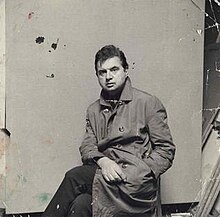
Bacon, photographed in the early 1950s
|
|
Today is the birthday of Francis Bacon (Dublin 28 October 1909 – 28 April 1992 Madrid); figurative painter known for his bold, grotesque, emotionally charged, raw imagery. He is best known for his depictions of popes, crucifixions and portraits of close friends. His abstracted figures are typically isolated in geometrical cage like spaces, set against flat, nondescript backgrounds. Bacon said that he saw images “in series”, and his work typically focuses on a single subject for sustained periods, often in triptych or diptych formats. His output can be broadly described as sequences or variations on a single motif; beginning with the 1930s Picasso-informed Furies, moving on to the 1940s male heads isolated in rooms or geometric structures, the 1950s screaming popes, and the mid-to-late 1950s animals and lone figures, the 1960s portraits of friends, the nihilistic 1970s self-portraits, and the cooler more technical 1980s late works.
Bacon took up painting in his late 30s, having drifted as an interior decorator, bon vivant and gambler. He said that his artistic career was delayed because he spent too long looking for subject matter that could sustain his interest. His breakthrough came with the 1944 triptych Three Studies for Figures at the Base of a Crucifixion, which sealed his reputation as a uniquely bleak chronicler of the human condition. From the mid-1960s he mainly produced portraits of friends and drinking companions, either as single or triptych panels. Following the 1971 suicide of his lover George Dyer, his art became more sombre, inward-looking and preoccupied with the passage of time and death. The climax of this later period is marked by masterpieces, including his 1982’s “Study for Self-Portrait” and Study for a Self-Portrait Triptych, 1985-86.
Despite his bleak existentialist outlook, Bacon in person was highly engaging and charismatic, articulate, well-read and unapologetically gay. He was a prolific artist, but nonetheless spent many of the evenings of his middle age eating, drinking and gambling in London’s Soho.
After Dyer’s suicide, he settled into a platonic and somewhat fatherly relationship with his eventual heir, John Edwards. The art critic Robert Hughes described him as “the most implacable, lyric artist in late 20th-century England, perhaps in all the world” and along with Willem de Kooning as “the most important painter of the disquieting human figure in the 50’s of the 20th century.” Francis Bacon was the subject of two Tate retrospectives and a major showing in 1971 at the Grand Palais. Since his death his reputation and market value have grown steadily, and his work is among the most acclaimed, expensive and sought-after. In the late 1990s a number of major works, previously assumed destroyed, including early 1950s popes and 1960s portraits, reemerged to set record prices at auction. In 2013 his Three Studies of Lucian Freud set the world record as the most expensive piece of art sold at auction.
While holidaying in Madrid in 1992, Bacon was admitted to the Handmaids of Maria, a private clinic, where he was cared for by Sister Mercedes. His chronic asthma, which had plagued him all his life, had developed into a respiratory condition and he could not talk or breathe very well.
He died of a heart attack on 28 April 1992, attempts to resuscitate him having failed. He had bequeathed his estate to John Edwards and Brian Clark, executor of the Estate. In 1998 the director of the Hugh Lane Gallery in Dublin secured the donation of the contents of Bacon’s chaotic studio at 7 Reece Mews, South Kensington. The contents of his studio were moved and reconstructed in the gallery. The relocated studio opened to the public in 2001. The entire contents of the studio have been catalogued: approximately 570 books, 1,500 photographs, 100 slashed canvases, 1,300 leaves from torn books, 2,000 artist materials, and 70 drawings. Other categories include artists correspondence, magazines, newspapers and vinyl records.
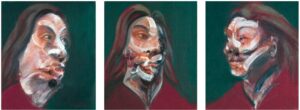

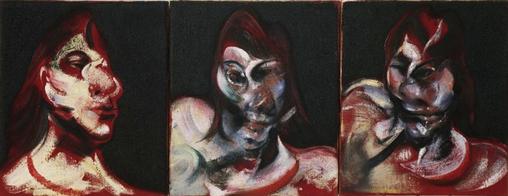

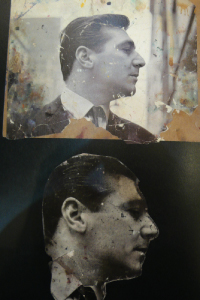


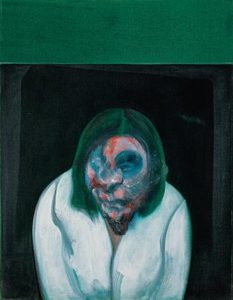
Head of a Woman 1960
Mac Tag


No Comments on "The Lovers’ Chronicle 28 October – the one – birth of Evelyn Waugh – art by Francis Bacon"